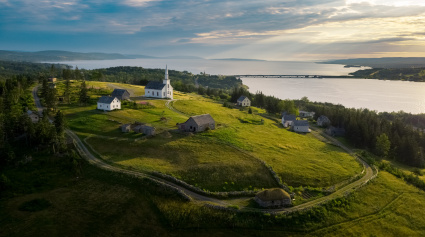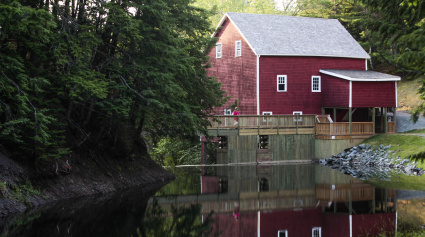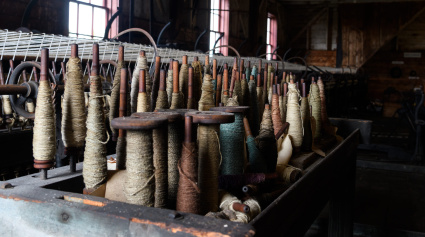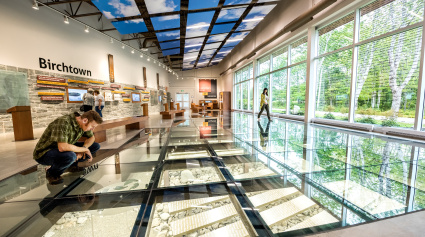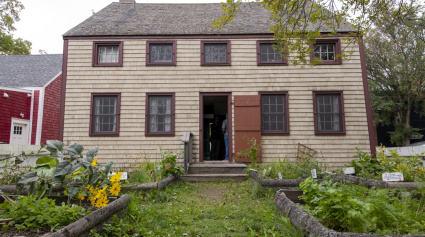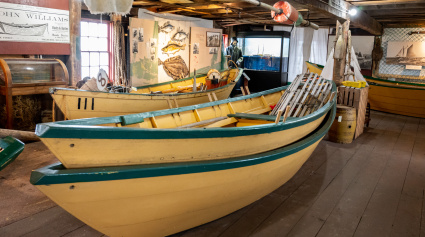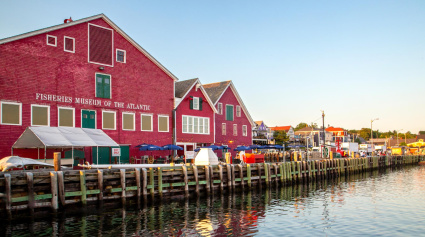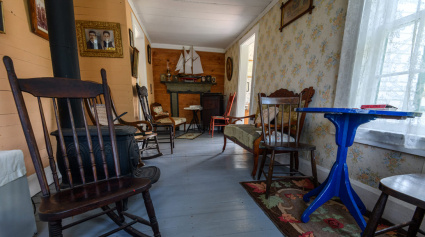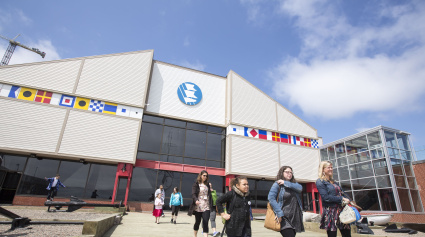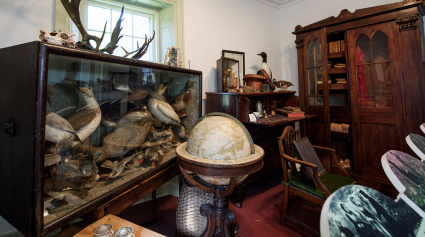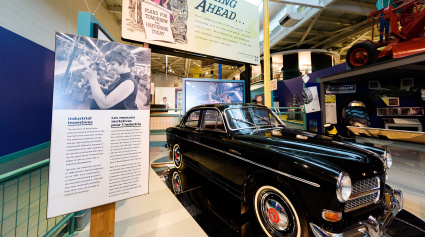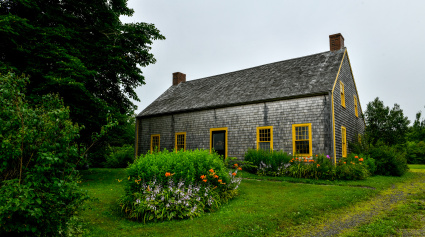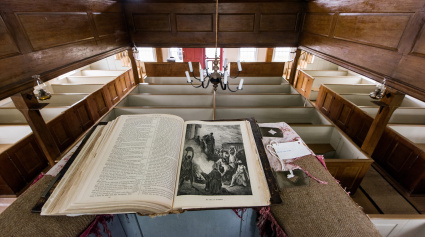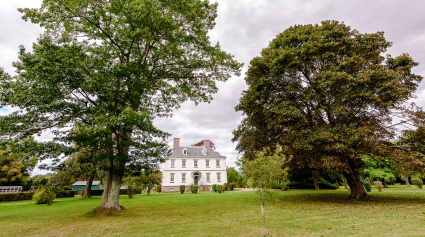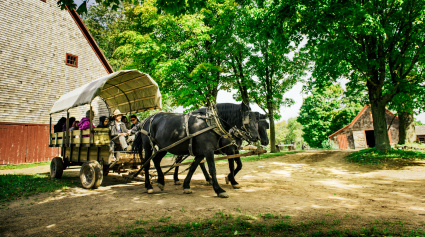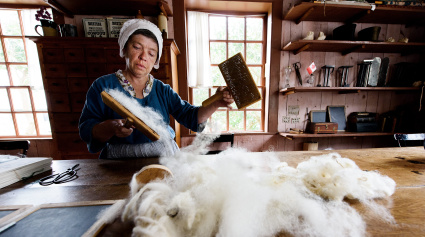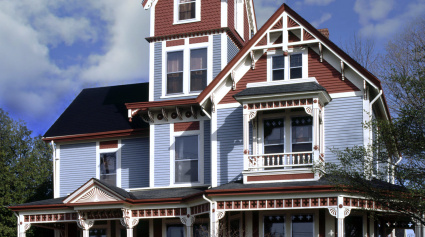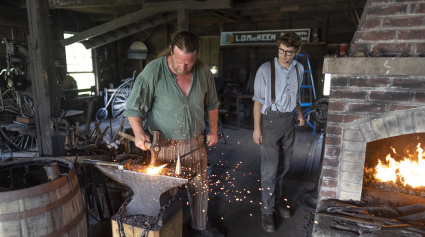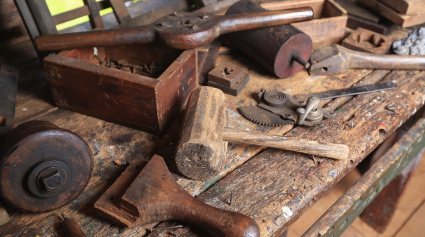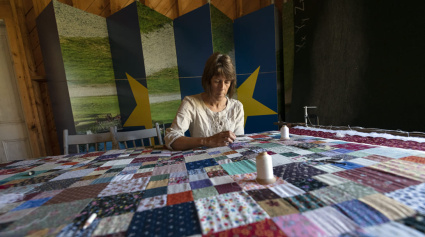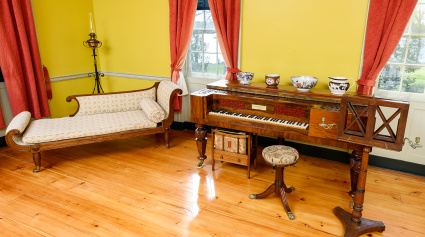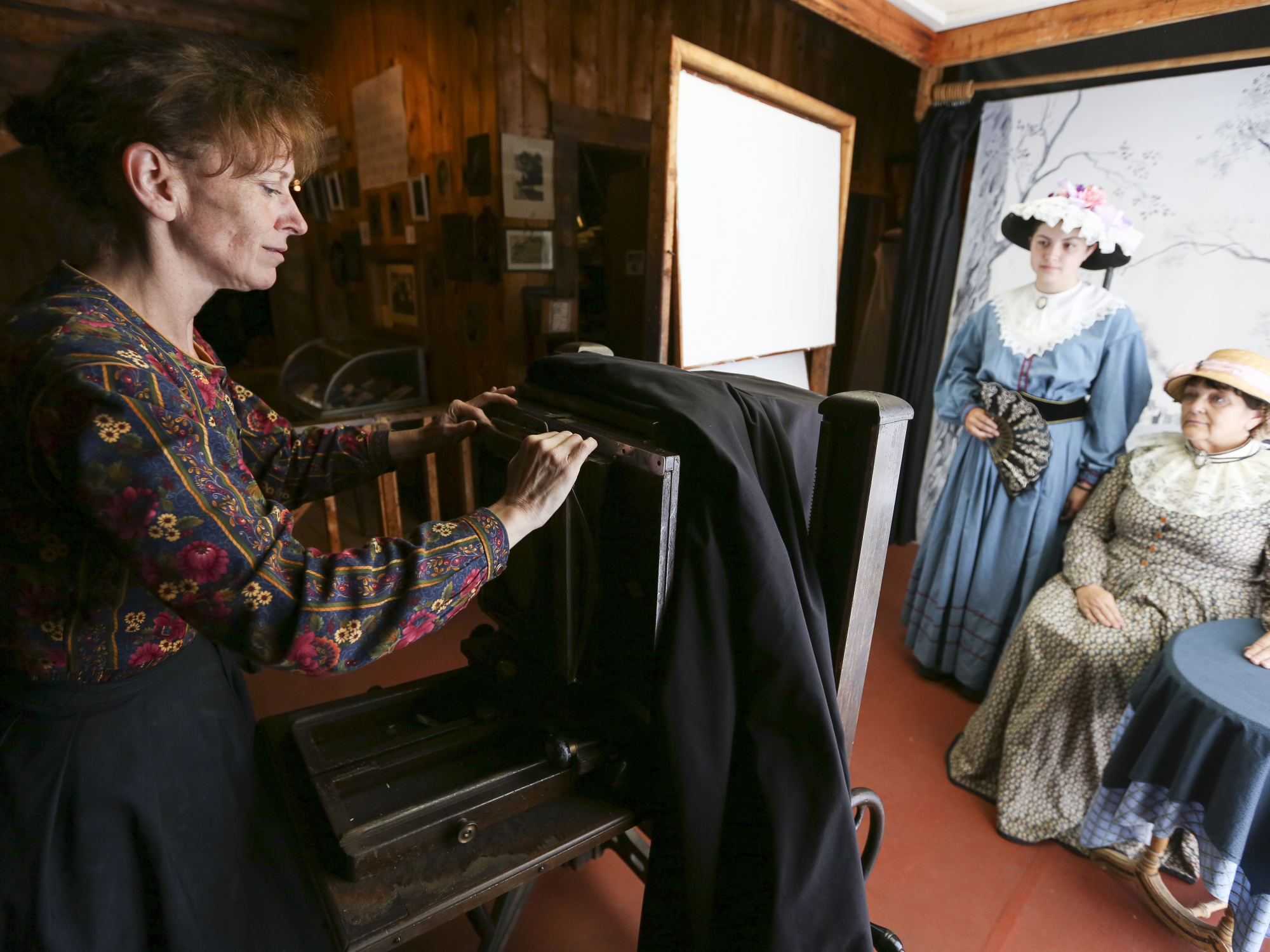
Baile nan Gàidheal | Highland Village
Iona, Cape Breton
Experience Nova Scotia’s Gaelic culture, heritage and hospitality at this living history museum and folk-life centre in scenic Iona, located in the heart of Cape Breton and overlooking the magnificent Barramens Strait on the Bras d’Or Lakes.
- Cultural History
Balmoral Grist Mill
Tatamagouche
Come discover Balmoral Grist Mill Museum; a three-storey mill tucked away in a wooded gorge on Matheson’s Brook.
See the mill in action, just as it would have been when Alexander McKay opened it in 1874. Hear the whir of wooden gears as shafts and pulleys turn the original Scottish granite millstones. Watch as grains are ground, sifted and turned into flour.
See the mill in action, just as it would have been when Alexander McKay opened it in 1874. Hear the whir of wooden gears as shafts and pulleys turn the original Scottish granite millstones. Watch as grains are ground, sifted and turned into flour.
Barrington Woolen Mill
Barrington
Discover how this busy, local industry of the late 1800s saved Nova Scotian women endless hours of washing, spinning and weaving their wool at home.
- Cultural History
- Industrial Heritage
Black Loyalist Heritage Centre
Shelburne
The Black Loyalist Heritage Centre tells the story of the world’s largest free African population outside of Africa, in the late 18th century in Nova Scotia.
Enjoy the view of Birchtown Bay when you climb up the Shaw Turret, which commemorates all Black Loyalist communities in Nova Scotia. Enter the Centre’s Lindsay Gallery and immerse yourself in the multimedia presentation of the Black Loyalist journey from Africa to the American colonies, then to Nova Scotia and back to Africa. Explore the virtual copy of the Carlton’s Book of Negroes and search for an ancestor who may have experienced part of this incredible journey.
Enjoy the view of Birchtown Bay when you climb up the Shaw Turret, which commemorates all Black Loyalist communities in Nova Scotia. Enter the Centre’s Lindsay Gallery and immerse yourself in the multimedia presentation of the Black Loyalist journey from Africa to the American colonies, then to Nova Scotia and back to Africa. Explore the virtual copy of the Carlton’s Book of Negroes and search for an ancestor who may have experienced part of this incredible journey.
- African NS Cultural Heritage
Clifton Museum Park
Windsor
Wind your way up the tree-lined drive to visit the beautiful park and grand home. Built in 1835 by Nova Scotian author and judge Thomas Chandler Haliburton and his wife Louisa, The property's sixteen owners and tenants each left their mark inside and out.
The word Clifton evolved from the Old English words clif (cliff or bank) and tun (town, settlement, farmstead), meaning town near the cliff. Situated in the town of Windsor along the banks of the Avon River, Louisa thought it was the perfect place to name after her hometown of Clifton, England.
The Birthplace of Hockey Museum is located in one wing of Clifton Museum. Filled with two hundred years of hockey history and artifacts, see the influences and evolution that led to the game we know today.
The word Clifton evolved from the Old English words clif (cliff or bank) and tun (town, settlement, farmstead), meaning town near the cliff. Situated in the town of Windsor along the banks of the Avon River, Louisa thought it was the perfect place to name after her hometown of Clifton, England.
The Birthplace of Hockey Museum is located in one wing of Clifton Museum. Filled with two hundred years of hockey history and artifacts, see the influences and evolution that led to the game we know today.
- Cultural History
Cossit House
Sydney, Cape Breton
Visit this historic home to discover how a controversial Loyalist Anglican minister and his wife started a new life in the capital of a rapidly growing British colony. Get to know Rev. Ranna Cossit and his wife, Thankful, who raised their family of ten children in this modest New England-style house. Chat with costumed guides and take part in daily activities of the 1700s, like stitching a sampler or churning butter. Come explore what may be the oldest house in Sydney.
- Cultural History
Dory Shop Museum
Shelburne
Step into this authentic harbour-side dory factory to discover the historic Shelburne Dory and enter the world of the famous Grand Banks fishery as it existed from 1880 to 1971.
Learn how Shelburne dorymakers rivaled their Lunenburg competitors by using the dory clip. Find out why the reliable dory was the backbone of the east coast fishery and the most popular small craft in the Atlantic Provinces for almost a century.
Learn how Shelburne dorymakers rivaled their Lunenburg competitors by using the dory clip. Find out why the reliable dory was the backbone of the east coast fishery and the most popular small craft in the Atlantic Provinces for almost a century.
- Marine History
Firefighters' Museum of Nova Scotia
Yarmouth
Imagine the clang of the fire bell, the smell of smoke and the feel of hot steam as firefighters of the past raced to save burning homes in Yarmouth and communities across Nova Scotia.
See types of fire engines used in Nova Scotia from the 1800s to the 1930s. Marvel at antique hand-drawn and operated engines such as Canada’s oldest horse-drawn steam engine, an 1863 Amoskeag Steamer. Take the wheel of a 1933 Chev Bickle pumper as you discover the history of firefighting in this province.
See types of fire engines used in Nova Scotia from the 1800s to the 1930s. Marvel at antique hand-drawn and operated engines such as Canada’s oldest horse-drawn steam engine, an 1863 Amoskeag Steamer. Take the wheel of a 1933 Chev Bickle pumper as you discover the history of firefighting in this province.
- History
Fisheries Museum of the Atlantic
Lunenburg
Learn about Rum Running, whales and August Gales. Have a yarn with old salts and enjoy Bluenose memorabilia. Walk the docks, visit our wharf-side vessels and refresh in the salt air as you take in one of the best maritime moments in the world.
- Marine History
Fisherman's Life Museum
Oyster Pond
From the crackle of wood burning in the cook stove, to the smell of the saltwater breeze, come experience the warmth and welcome of Nova Scotia’s Eastern Shore in a fishing family’s home.
- Marine History
Fundy Geological Museum
Parrsboro
Come and explore Nova Scotia’s ancient world near the Bay of Fundy, where the world’s highest tides erode the towering sea cliffs to reveal evidence of 350 million-year-old fossils and local minerals, including amethyst and agate gem stones.
- Geology
- Archaeology
Lawrence House Museum
Maitland
Come visit his bright Victorian home and enjoy photographs, exhibits and tours that feature Lawrence’s era of shipbuilding, as well as tales of the Golden Age of Sail in Maitland.
- Cultural History
- Marine History
Maritime Museum of the Atlantic
Halifax
From small craft boatbuilding to World War Convoys, the Days of Sail to the Age of Steam, the Titanic to the Halifax Explosion, you’ll discover the stories, events and people that have come to define this province and its relationship with the sea.
- Mi’kmaq Cultural Heritage
- Marine History
McCulloch House Museum
Pictou
Dr. Thomas McCulloch, came ashore in 1803 and soon found himself leading a monumental change in the lives of 19th century Nova Scotians. Visit McCulloch’s 200-year-old brick home and explore exhibits that detail how one man’s passion launched him on a journey to create public education in this province.
- Cultural History
Museum of Industry
Stellarton
Come explore Atlantic Canada’s largest museum to discover the people, places and machines of Nova Scotia’s industrial past. Push, pull, lift, drop and laugh as you enjoy acres of exhibits and interactive displays that highlight how technology – and people – worked throughout this province’s history.
- Industrial Heritage
Museum of Natural History
Haifax
The museum has transitioned through multiple locations and identities, evolving from the Provincial Museum in 1868 to the Nova Scotia Museum of Science in 1947.
North Hills Museum
Granville Ferry
Built around 1764, the exterior of this small farmhouse looks like a typical country home, but inside it boasts a collection of fine art and furnishings that create an air of Georgian elegance.
- Cultural History
Old Meeting House
Barrington
Among the oldest in North America, this meeting house was a building-in-progress for its first hundred years. Built by Congregationalist fishermen and farmers from Cape Cod, called Planters, the windows, doors, box pews, and a pulpit were added by the mid-1800s.
- Cultural History
Perkins House Museum
Liverpool
Every day for over 40 years, Simeon Perkins recorded details in his diary about life, family and business in Liverpool. From mentions of ships’ captains, to notes about goods coming and going, to remarks about his house, American privateers, children being born and even the threat of the smallpox epidemic of 1800, Simeon’s observations provide a personal perspective on life in Nova Scotia from 1766 to 1812.
Discover the nooks and crannies of Perkins’ historic home. Step into the parlour and picture this merchant and community leader seated in an elegant mahogany wing chair, dipping his quill in ink as he captured the details of daily life.
Discover the nooks and crannies of Perkins’ historic home. Step into the parlour and picture this merchant and community leader seated in an elegant mahogany wing chair, dipping his quill in ink as he captured the details of daily life.
Prescott House
Port Williams
Come calling at “Acacia Grove”, an elegant Georgian house in the picturesque Annapolis Valley. Here, horticulturalist Charles Prescott cultivated Nova Scotia’s apple industry from 1811 to 1859.
Discover how his great grand daughter, Mary Allison Prescott, rescued the derelict building in the 1930s to recreate a gracious home. See family portraits, antique furnishings and Miss Prescott’s collections of hand-stitched samplers and tribal Oriental carpets. Delight in the garden and lush countryside surrounding this special place.
Discover how his great grand daughter, Mary Allison Prescott, rescued the derelict building in the 1930s to recreate a gracious home. See family portraits, antique furnishings and Miss Prescott’s collections of hand-stitched samplers and tribal Oriental carpets. Delight in the garden and lush countryside surrounding this special place.
Ross Farm Museum
New Ross
Come to Ross Farm Museum to explore 60 acres of rolling farmland and discover what life was like on a Nova Scotia family farm over 100 years ago.
- Cultural History
Ross-Thomson House Museum
Shelburne
Travel back to 1780s Nova Scotia and the recently settled townof Shelburne. Here, thousands of Loyalist refugees began new lives after the American War of Independence.
- Cultural History
Shand House Museum
Windsor
Imagine life in this Queen Anne-style house as you discover the Shand family legacy. Featuring an original indoor bathroom, central heating and stylish furniture from the Windsor Furniture Factory, this ornate house was considered a modern marvel when it was built for newlyweds Clifford and Henrie in 1890. Take the servant’s stairs to the upper floor and climb the tower for a magnificent view of the Avon River and countryside, a beautiful setting for this comfortable family home.
Sherbrooke Village
Sherbrooke
In the 1860s, timber, tall ships and gold ruled life along the St. Mary’s River, turning the community of Sherbrooke into a prosperous boom town. Today, the picturesque village still stands proud, just as it did more than 100 years ago.
Sutherland Steam Mill
Denmark
Explore this 1894 saw mill and discover Nova Scotian ingenuity in a mill once powered by steam. For nearly 70 years, Alexander Sutherland and his family produced carriages, sleds, windows, and fancy gingerbread trim, which were shipped on the old railway line beside the mill.
- Cultural History
- Industrial Heritage
The Acadian Village of Nova Scotia
Lower West Pubnico
Founded in 1653 by Sieur Philippe Mius-d’Entremont, this remarkable community showcases the industrious and joyful spirit of the Acadian people, celebrating a language and culture that has thrived for more than 350 years.
- Cultural History
- Marine History
Uniacke Estate Museum Park
Mount Uniacke
Uniacke Estate Museum Park is part of what was the expansive country estate of Attorney-General Richard John Uniacke (1753-1830). Built between 1813 and 1815, the grand country house is one of the finest examples of Georgian architecture in Canada. The estate offers visitors a vivid glimpse of life in the early 1800s among Nova Scotia's gentry.
- Cultural History
Wile Carding Mill
Bridgewater
From 1860 to 1968, this water-powered mill lightened the workload for Nova Scotian farm families by carding a week’s worth of wool in one hour! See the very machine that revolutionized carding in the area and imagine the clatter as it prepared wool for bedding and spinning. Step outside and picture the line of ox carts that would wait patiently as women operators processed loads of sheep fleece.
Wile Carding Mill’s overshot waterwheel still turns in its tranquil setting on Sandy Brook, a reminder of a once vibrant industrial centre.
Wile Carding Mill’s overshot waterwheel still turns in its tranquil setting on Sandy Brook, a reminder of a once vibrant industrial centre.
- Industrial Heritage
